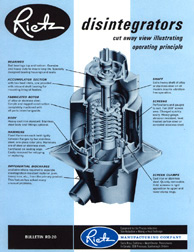

| His "vertical" machine was easy to sterilize and such an improvement over existing disintegrators that it became the standard for the food, chemical and paper processing industries. His innovations, though considered radical in the 1930s and 1940s, would soon lay the foundation for modern, industrial processing in the United States and world-wide. |

|
||